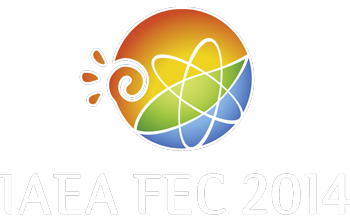Speaker
Mr
Alexander Tukachinsky
(Ioffe Institute)
Description
The bursts of high frequency (~ 1 МHz) oscillations have been registered by magnetic probes in experiments carried out on the TUMAN-3M tokamak. The line averaged plasma density was ne < 2.5*1019 m-3 and BT ~ (0.7 – 1)T, the regimes were both ohmic and NBI-heated.
The gaps in oscillation spectra between high and low frequency parts of the spectra were observed under conditions mentioned above. The frequency in the higher part of the spectrum followed the dependence of Alfven wave velocity VA on magnetic field strength and plasma density. This dependence allows identifying the high frequency waves as Alfven waves.
When ne was increased, the gap disappeared because oscillation frequency decreased and entered the region of high level noise. The Alfven wave identification became difficult. The neutral beam injection did not effect noticeably the Alfven oscillations.
Alfven waves are usually excited by fast ions in tokamak experiments [1,2], but in ohmic regimes fast ions are practically absent. The high frequency oscillations (electron fishbones) produced by fast electrons were also observed in ECRH and LHCD experiments [3]. The bursts of oscillations observed in the TUMAN-3M experiments were excited in OH regimes at the moments of internal disruptions, sawteeth, when fast reconnection led to fast change in magnetic field geometry and its magnitude. Fast magnetic field oscillations were observed during internal (gongs [4]) and minor [5] disruptions. However, in these papers the possibility of the Alfven wave generation was not considered.
At some moments oscillations looked as beats of waves with close frequencies, reflecting the spectrum width.
The Alfven mode localized in the plasma core has been apparently observed. In the plasma center the ratio ∆B/B is small (when r→0 then ∆B/B→0) and the so called “gap mode” does not necessarily exist. For this mode frequency should be f≈VA/4πRq. In our experiments the observed frequency was f≈VA/2πR, so for q ≥1 the mode was apparently not a gap mode.
[1] Wong, K.L., Plasma Phys. Control. Fusion 1999 41 R1.
[2] D Curran, Ph Lauber, P J Mc Carthy et al Plasma Phys. Control. Fusion 2012, 055001
[3] Zonca F. et al, Nuclear Fusion 2007, 47,1588
[4] Duperrex P.A., Pochelon A. et al, Nuclear Fusion, (1992) 32, 7, 1161
[5] Savruhin P. et al EX/P4-34, 24 IAEA FEC Conference, 2012
| Country or International Organisation | Russian Federation |
|---|---|
| Paper Number | EX/P6-57 |
Author
Mr
Alexander Tukachinsky
(Ioffe Institute)
Co-authors
Dr
Leonid Askinazi
(Ioffe Institute)
Mr
Maxim Vildjunas
(Ioffe Physical-Technical Institute)
Dr
Sergei Lebedev
(Ioffe Physical-Technical Institute, Russian Academy of Sciences)
Mr
Vladimir Kornev
(Ioffe Institute)

